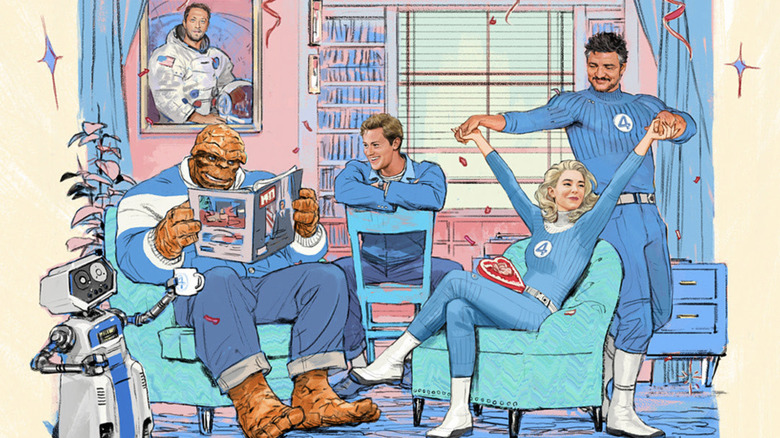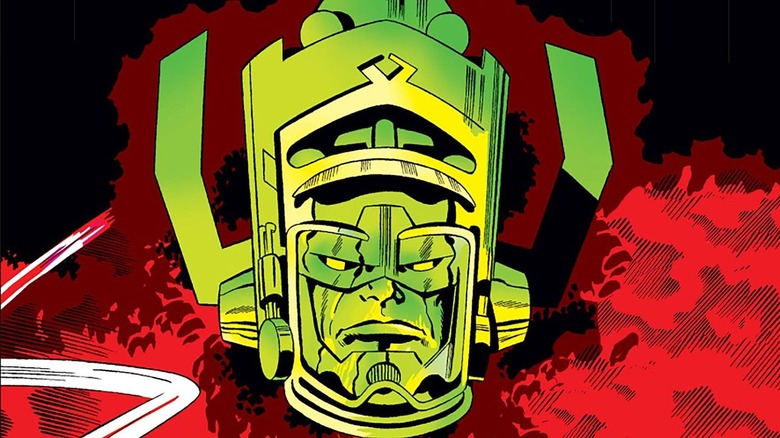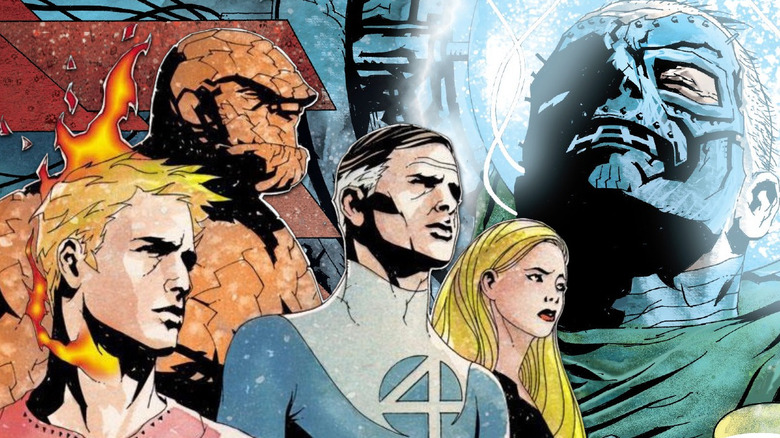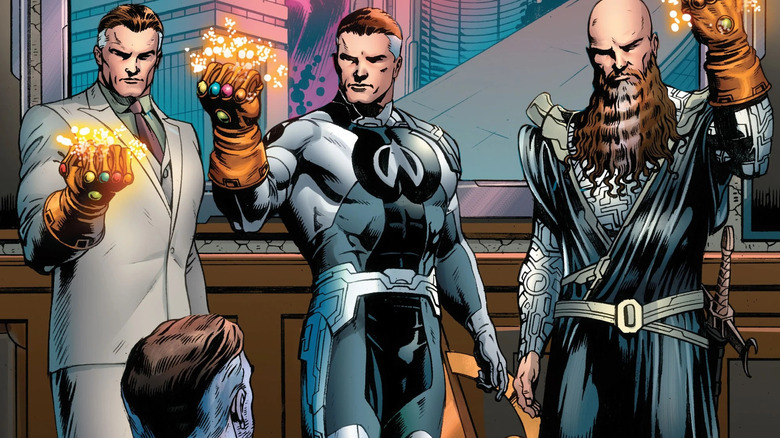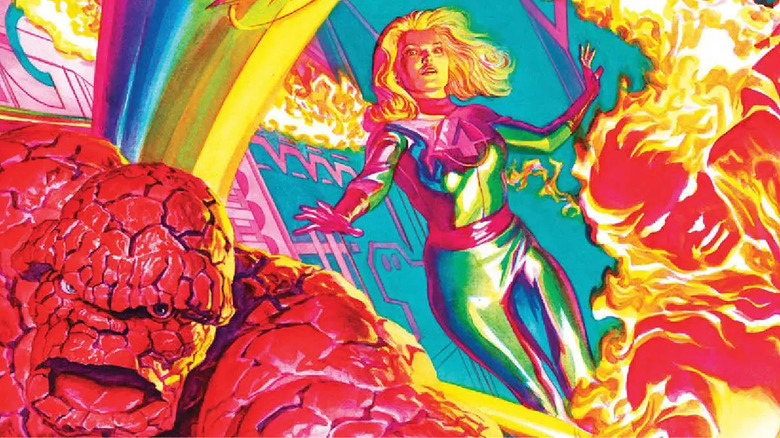4 Fantastic Four Comics That Marvel Fans Should Read, Ranked
Marvel Studios' Valentine's Day gift to its audience this year was finally announcing the long-awaited cast for its "Fantastic Four" movie: Pedro Pascal as Mister Fantastic, Vanessa Kirby as the Invisible Woman, Ebon Moss-Bachrach as The Thing, and Joseph Quinn as "Human Torch."
The announcement went a step further with a drawn poster depicting the actors' likenesses on the page in a fuzzy style suggesting a 1960s period setting. If only you could see similarly exquisite drawings of the Fantastic Four... oh wait, you can — 60+ years' worth of them in the Four's serialized comic books. That comic series, which debuted in 1961, is the stone on which Marvel's cultural capital was built.
Previous "Fantastic Four" movies have not done a good job of introducing the Fantastic Four to audiences. So, if you're a Marvel Cinematic Universe fan ready to love this new family of heroes, here are some good beginner suggestions for which comics to read (limited to four in the spirit of the characters.)
The listed comics can all be read on the digital subscription reading service, Marvel Unlimited.
The Original Galactus Trilogy (Fantastic Four #48-50)
Jack Kirby was already a veteran of the comics industry when he and Stan Lee started publishing "Fantastic Four," but the book remains the keystone of his art. Kirby's imagination ran rampant in devising new adventures for the Four and his later books, from "Thor" to "New Gods" at DC Comics, trace their roots to "Fantastic Four."
Kirby and Lee made 102 issues of "Fantastic Four" together in total. At the midpoint of the run, in acknowledgment of their success, they did a big story: the Fantastic Four fight Galactus, a being who has come to devour Earth itself.
These three issues ("Fantastic Four" #48-50), now known as "The Galactus Trilogy," form the first Marvel Comics "event," meaning a comic with high stakes and an ensemble of heroes. But no later Marvel event (and there have been many) has inspired dread like "The Galactus Trilogy" does. And yes, I count the multi-movie build-up to the threat of Thanos in the Marvel Cinematic Universe in that assessment.
Gaze upon the cover of issue #48, with Uatu The Watcher recoiling in terror as the Four stands among a crowd, looking to the sky in terrified awe. The empty space of the cover is filled with a proclamation: "The Coming of Galactus!" Just who could this threat be? The final page of the issue debuts the villain in all his glory.
Issue #49 cover shows the four running in defeat as Galactus' head looms over them, while issue #50 has a featureless brown background. However, that lack of detail is to highlight the Silver Surfer — herald of Galactus turned savior of Earth — in a pose where he looks like he might zoom off the page.
The story's dialogue might read as overwrought and wooden to a modern ear, but Kirby's penciled images are indelible.
Fantastic Four: 1234
If you're trying to get into comics, Grant Morrison is a name to remember. Most of their superhero work has been done over at DC, though; they only wrote for Marvel during a brief time in the early 2000s. The main product of that partnership was "New X-Men" (2001-2004), but Morrison also got to try their hand at the FF by penning the mini-series "Fantastic Four: 1234."
The story is typical "Fantastic Four." Doctor Doom enacts a scheme to tear apart the Four from within, recruiting other adversaries of theirs like Namor the Sub-Mariner and the Mole Man. Morrison focuses an issue on each individual member of the team (Ben, Sue, Johnny, and then Reed). However, Jae Lee's dark and sharp watercolors couldn't be further from Kirby's bright alien realms, and that art keeps the series relatively down to Earth.
Reed doesn't get much page time (he spends most of the series in solitude, thinking) but I love how the book parallels him and Doom (even if Morrison is egalitarian enough to make sure that one-time damsel in distress Sue gets to give the beatdown on Doom in issue #4). "1234" suggests Doom is simply Reed's id, the face he keeps masked like Victor literally does to his. Conversely, if Doom could let go of his petty grievances, he'd be a man as great as Reed.
Solve Everything (Fantastic Four #570-572)
From 2008 to 2015, writer Jonathan Hickman wrote a series-spanning epic across the Marvel Universe, culminating in "Secret Wars." While "Avengers"/ "New Avengers" were the comics that led up to that event, Hickman's "Fantastic Four" was just as vital. The final conflict of "Secret Wars" comes down to Reed Richards and Victor Von Doom and which one of them can better save the universe.
A 100+ issue story probably sounds daunting, but thankfully, with Hickman's "Fantastic Four," you can start small. His first three "Fantastic Four" issues (#570-572) form a story called "Solve Everything" (drawn by Dale Eaglesham). Start here and, if you like it, keep reading.
"Solve Everything" is a character study of Reed Richards. As a scientist, he solves problems and braves the unknown. As a superhero scientist, though, he feels like he can do more. Then, he gets an invite from the Council of Reeds — a coalition of his multiversal selves who've banded together to solve the world's (all worlds') problems. However, despite their achievements (many wield Infinity Gauntlets), these Reeds have left behind their families and that's something "our" Reed can't do.
The story opens and closes with flashbacks to Reed's childhood. In the beginning, his father Nathaniel tells him he must risk failure to be great. In the end, Nathaniel reminds his son that being a great man means more than being a great scientist — it also means being a great friend, husband, etc. "Solve Everything" is tied up in a bow, but Hickman keeps wrestling with these ideas as his run carries on.
Fantastic Four (2022-)
The Fantastic Four are not only superheroes, they're scientists and explorers. The current "Fantastic Four" run, written by Ryan North, understands this; North is writing a science-fiction mystery comic just as much as a superhero one.
The art, drawn mostly by Iban Coello, isn't as revelatory as the work of past "Fantastic Four" artists like Kirby or John Byrne (or even the book's own covers drawn by Alex Ross, who excels in painting photorealism of the absurd). Then again, the Marvel house style exists as such because it gets the job done.
North writes fantastic mysteries like the type you'd see on "The X-Files" or "Fringe." In his debut issue, the Thing and his wife Alicia Masters wind up in a small town — a town stuck in a time loop since 1947. This lends "Fantastic Four" an enjoyable episodic quality; like the comics of the 1960s, each one can be read on its own terms.
North also writes an excellent Doctor Doom. In his seventh issue (which is "Fantastic Four" #700 when counting back from the very beginning), Doom travels through time to undo a mistake of Reed's, thereby proving himself the man's superior. But every temporal revision he makes results in a worse future, and Doom must confront the possibility that his ambitions have carried him as far as they can go, short of their peak.
The issue's title? "The Enemy of Good," a delightful double entendre. Doctor Doom is not just a villain, he's a perfectionist.
"Fantastic Four" is currently scheduled to open in theaters on July 25, 2025.
